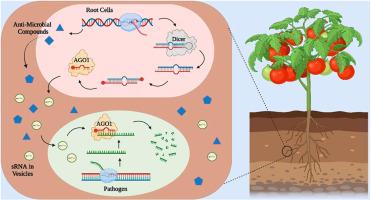跨界RNA转运——植物病害管理的新工具
IF 3.3
3区 农林科学
Q2 PLANT SCIENCES
引用次数: 0
摘要
小rna (sRNAs)是一组不同的内源性非编码rna,它们调节发育、基因组稳定性和植物对生物和非生物胁迫的反应。根据其起源和生物发生,sRNAs大致分为microRNAs (miRNAs)、小干扰RNA (sirna)和次级sirna,每一种RNA都是通过不同但部分重叠的途径产生的,包括dicer样酶、RNA依赖的RNA聚合酶和Argonaute蛋白。除了局部作用外,sRNAs还表现出显著的移动性:它们通过胞间连丝在邻近细胞之间移动,并通过韧皮部系统地移动,从而协调发育和免疫反应。最近的进展已经确定srna是跨界通信的核心参与者。植物病原体分泌sRNAs作为效应物,通过靶向免疫相关转录物抑制宿主防御。相反,植物可以将sRNAs输出到病原体中以阻止病原体毒力基因的表达。因此,抑制毒力基因可以减少宿主与病原体的相互作用,从而减少宿主植物的发病机制。这些发现为宿主诱导基因沉默(HIGS)和喷雾诱导基因沉默(SIGS)等创新方法奠定了基础,这些方法利用sRNA的流动性来实现可持续的作物保护。此外,可移动的sRNAs的稳定性受到保护机制的支持,如韧皮部汁液中的低RNase活性和潜在的化学修饰,包括甲基化和糖基化。除病原体外,有益微生物和生物防治剂也参与与宿主的sRNA交换,影响免疫和疾病结果。本文综述了近年来在了解sRNA的生物发生、转运和调控作用方面的进展,并强调了它们作为开发下一代基于rna的生物农药用于可持续农业疾病管理的前景。本文章由计算机程序翻译,如有差异,请以英文原文为准。

Cross kingdom RNA trafficking - A novel tool for plant disease management
Small RNAs (sRNAs) are a diverse group of endogenous non-coding RNAs that regulate development, genome stability, and plant responses to biotic and abiotic stresses. Based on their origin and biogenesis, sRNAs are broadly categorized into microRNAs (miRNAs), small interfering RNAs (siRNAs), and secondary siRNAs, each generated through distinct yet partially overlapping pathways involving Dicer-like enzymes, RNA-dependent RNA polymerases, and Argonaute proteins. In addition to acting locally, sRNAs exhibit remarkable mobility: they move between neighboring cells through plasmodesmata and travel systemically via the phloem, thereby coordinating developmental and immune responses. Recent advances have established sRNAs as central players in cross-kingdom communication. Plant pathogens secrete sRNAs as effectors to suppress host defense by targeting immunity-associated transcripts. Conversely, plants can export sRNAs into pathogens to prevent the expression of pathogen virulent genes. Thus, the suppression of virulence genes can diminish the host-pathogen interaction, resulting in reduced pathogenesis in the host plant. These discoveries underpin innovative approaches such as host-induced gene silencing (HIGS) and spray-induced gene silencing (SIGS), which harness sRNA mobility for sustainable crop protection. Moreover, the stability of mobile sRNAs is supported by protective mechanisms such as low RNase activity in phloem sap and potential chemical modifications, including methylation and glycosylation. Beyond pathogens, beneficial microbes and biocontrol agents also engage in sRNA exchange with hosts, influencing immunity and disease outcomes. This review highlights recent progress in understanding sRNA biogenesis, trafficking, and regulatory roles, and emphasizes their promise as a foundation for developing next-generation RNA-based bio-pesticides for sustainable agricultural disease management.
求助全文
通过发布文献求助,成功后即可免费获取论文全文。
去求助
来源期刊
CiteScore
4.30
自引率
7.40%
发文量
130
审稿时长
38 days
期刊介绍:
Physiological and Molecular Plant Pathology provides an International forum for original research papers, reviews, and commentaries on all aspects of the molecular biology, biochemistry, physiology, histology and cytology, genetics and evolution of plant-microbe interactions.
Papers on all kinds of infective pathogen, including viruses, prokaryotes, fungi, and nematodes, as well as mutualistic organisms such as Rhizobium and mycorrhyzal fungi, are acceptable as long as they have a bearing on the interaction between pathogen and plant.

 求助内容:
求助内容: 应助结果提醒方式:
应助结果提醒方式:


